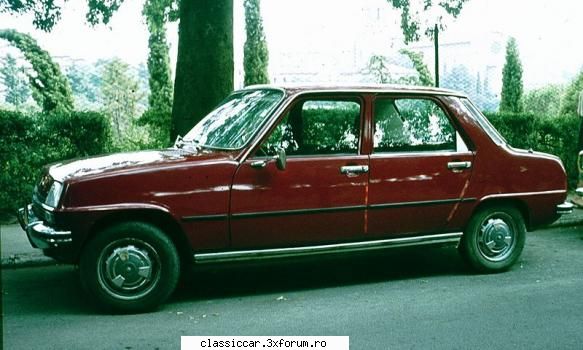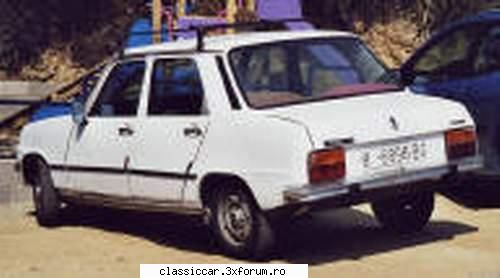Misu de Cluj
Admin
 Din: Cluj-Napoca
Inregistrat: acum 17 ani
Postari: 48329
|
|
Renault 7 este un Renault 5 din prima generatie cu caroseria in trei volume, care a fost fabricat doar in Spania.
The Renault R7 (partly also Renault Siete called) was a passenger car model of the French manufacturer Renault. It was manufactured from 1974 to 1983 and sold altogether 240,000 times.
It concerns with the R7 a four-door notchback sedan of the lower middle class, which was identical up to the C-column to the version of the R5 of the first generation (1977-1985) as far as possible. The engine pallet for the R7 was however due to the higher weight in the comparison to the R5 something reduced (only 1100cm - engine with 33kW (45PS)).
Model history
Originally the Renault R5 in three body forms should be manufactured: when (1973 presented) went, as well as (1977 presented) and as four-door Limousine.Der as addition of the according to plan into series, of which sedan prototypes up to production stage became developed, in the last moment however stopped. Reasons for the fact can have been that this car would have held customers from the purchase of the larger Renault R6, in addition, that it would have watered the image of the R5 as compact small car by the absence of the salient tail. Since plants for a production were purchased however already in France, one decided to take up itself production with the Spanish Renault daughter FASA to Valladolid, particularly since completely different purchase behavior of the potientiellen customers had been present there than in the Western European countries. After the end of the construction period the R7 was not replaced, also not by a notchback version on the basis of the new R5, which maintained outwardly the silhouette of the predecessor.
The Thalia offered on the basis of the R5-Nachfolgers Clio can be considered however indirectly as successors of the R7.
Pictures
The pictures show a Renault R7, how he is still driven into Spain.
Related links
Wiki: Renault 7
The Renault 7 (or "R7" is a 4-door saloon version of the Renault 5 supermini, produced and sold in Spain by Renault's subsidiary, FASA-Renault from 1974 to 1984. is a 4-door saloon version of the Renault 5 supermini, produced and sold in Spain by Renault's subsidiary, FASA-Renault from 1974 to 1984.
It was very similar to the R5, and identical mechanically, but offered with a smaller range of engines. The R7 had four doors and a saloon-style boot in place of the original car's three (and later five) doors including hatchback. Another difference was the use of metal bumpers instead of plastic ones, giving the car a slightly older looking, though perhaps also more expensive looking design. Initially powered by a 1037 cc engine, it was mostly sold in Spain. About 140,000 units were produced, and its success outside its home market was limited because Renault offered a more practical car, the larger Renault 12, for a small difference in price.
The R7 was introduced two years after the launch of the R5, then restyled in 1979, followed by an engine upgrade to 1108 cc in 1980. Its production ended in 1982, when the brand new R9 entered the worldwide market. What's more, a five-door version of the R5 was launched in 1980 using the door pattern of the Spanish R7. The R5 had been substantially restyled and R7 sales did not justify the investment necessary to renew the tooling for the R7.
Renault 7 [1]
Manufacturer Renault
Production 1974 - 1984
Predecessor None
Successor Renault Clio Saloon
Class Supermini
Body style(s) 4-door saloon
Layout MF layout
Engine(s) 1.0 L I4, 50 PS (49 hp/37 kW)
1.1 L I4, 50 PS (49 hp/37 kW)
Wheelbase 2505 mm (98.6 in) (right)
2535 mm (99.8 in) (left)
Length 3890 mm (153.1 in)
Width 1525 mm (60 in)
Height 1400 mm (55.1 in)
Curb weight 815 kg (1797 lb)
Renault Siete / R7
The R7 is a 4-door saloon version of the R5 produced and sold in Spain by Renault's subsidiary, FASA-Renault from 1974 to 1984.
It was very similar to the R5, and identical mechanically, but offered with a smaller range of engines. The R7 had four doors and a saloon-style boot in place of the original car's three (and later five) doors including hatchback. Another difference was the use of metal bumpers instead of plastic ones, giving the car a slightly older, though perhaps also more expensive looking design. Initially powered by a 1037 cc engine, it was mostly sold in Spain. About 140,000 units were produced, and its success outside its home market was limited because Renault offered a more practical car, the larger Renault 12, for a small difference in price.
The R7 was introduced two years after the launch of the R5, then restyled in 1979, followed by an engine upgrade to 1108 cc in 1980. Its production ended in 1982, when the brand new R9 entered the worldwide market. What's more, a five-door version of the R5 was launched in 1980 using the door pattern of the Spanish R7. The R5 had been substantially restyled and R7 sales did not justify the investment necessary to renew the tooling for the R7.
_______________________________________
NU TOATE MASINILE VECHI SUNT RABLE! 
UN POPOR CARE ISI INGROAPA TRECUTUL, NU VA AVEA VIITOR! 
SUNT MANDRU DE RABLELE MELE !!! 
|
|

 is a 4-door saloon version of the Renault 5 supermini, produced and sold in Spain by Renault's subsidiary, FASA-Renault from 1974 to 1984.
is a 4-door saloon version of the Renault 5 supermini, produced and sold in Spain by Renault's subsidiary, FASA-Renault from 1974 to 1984.






